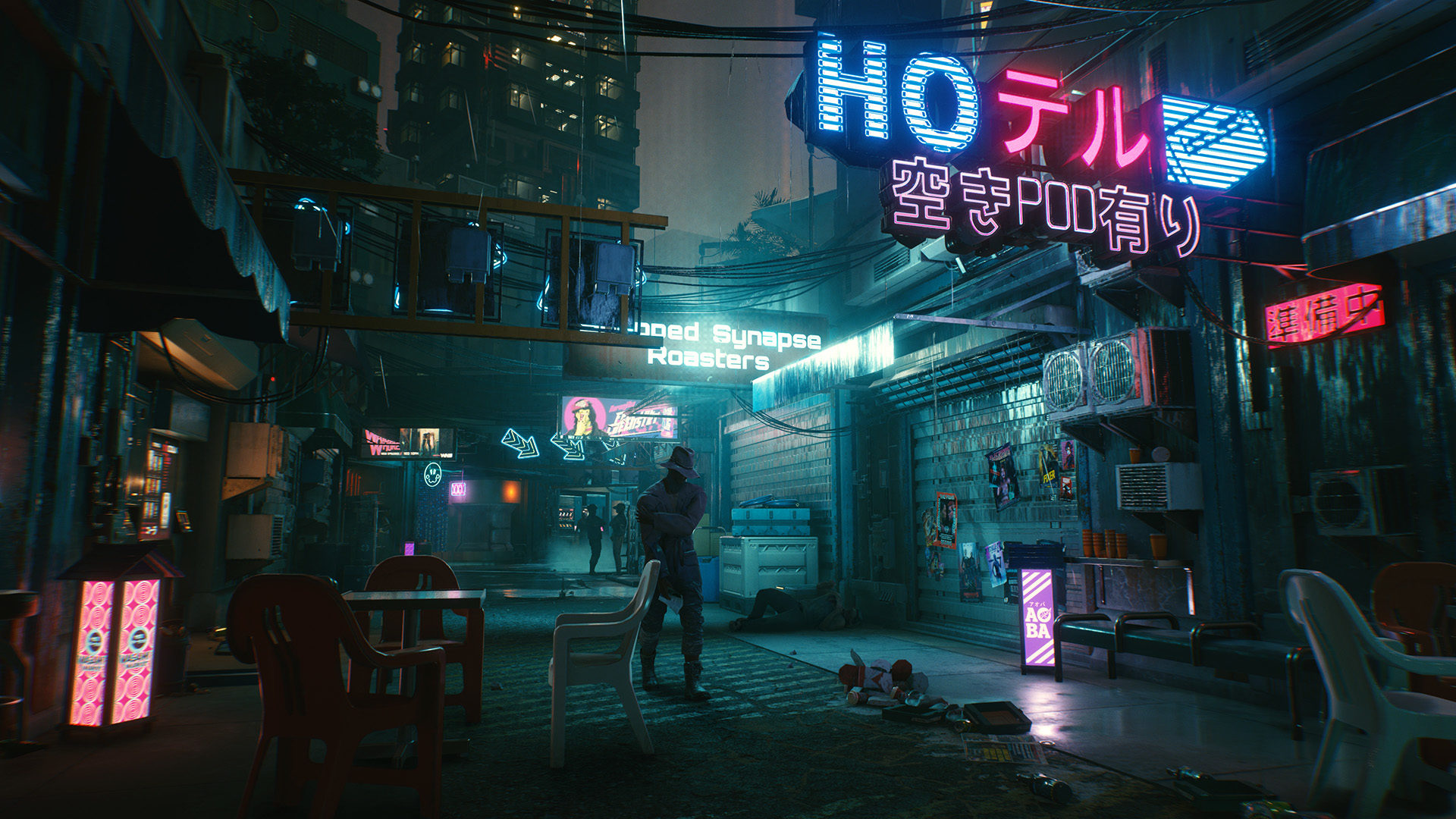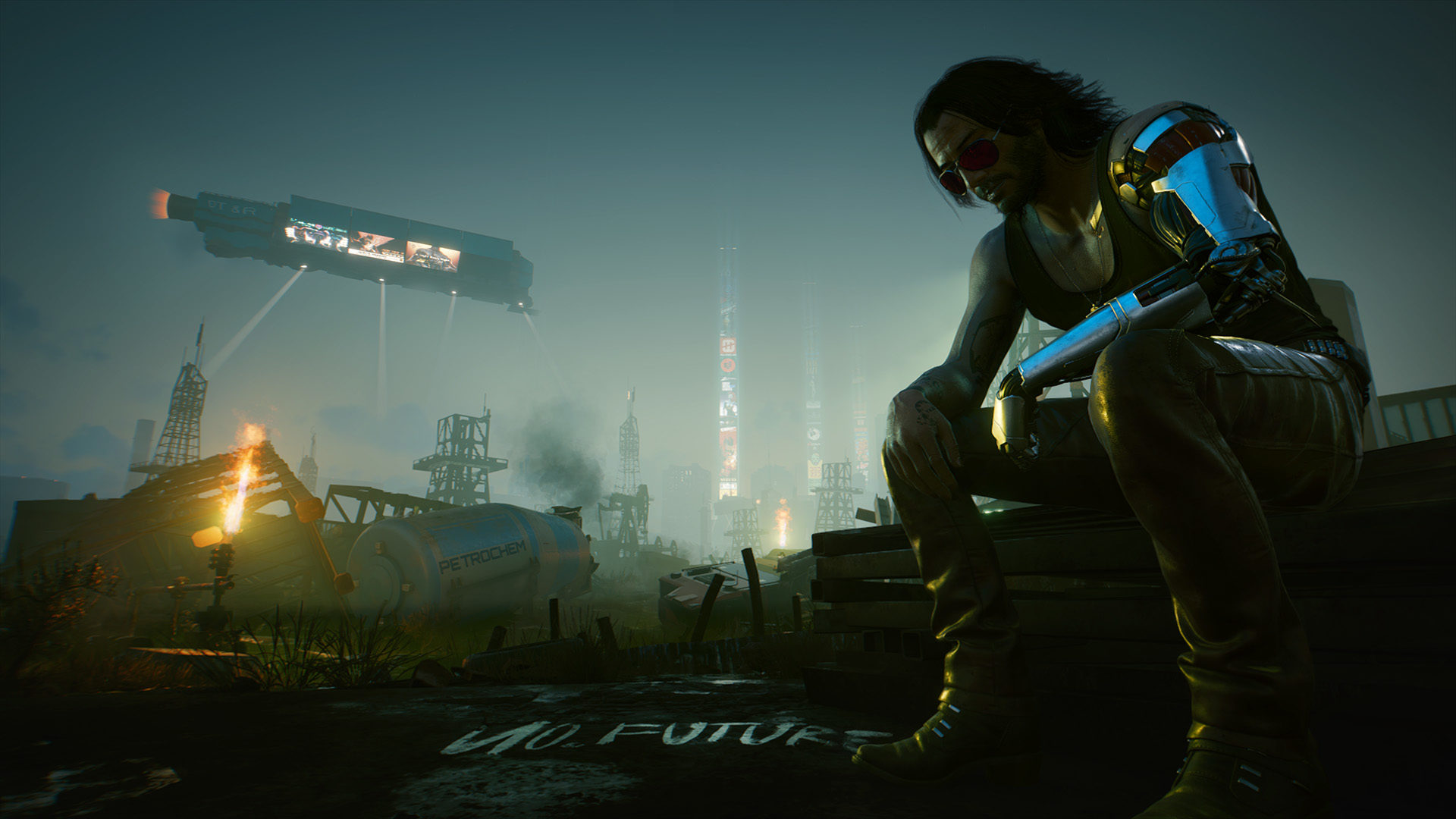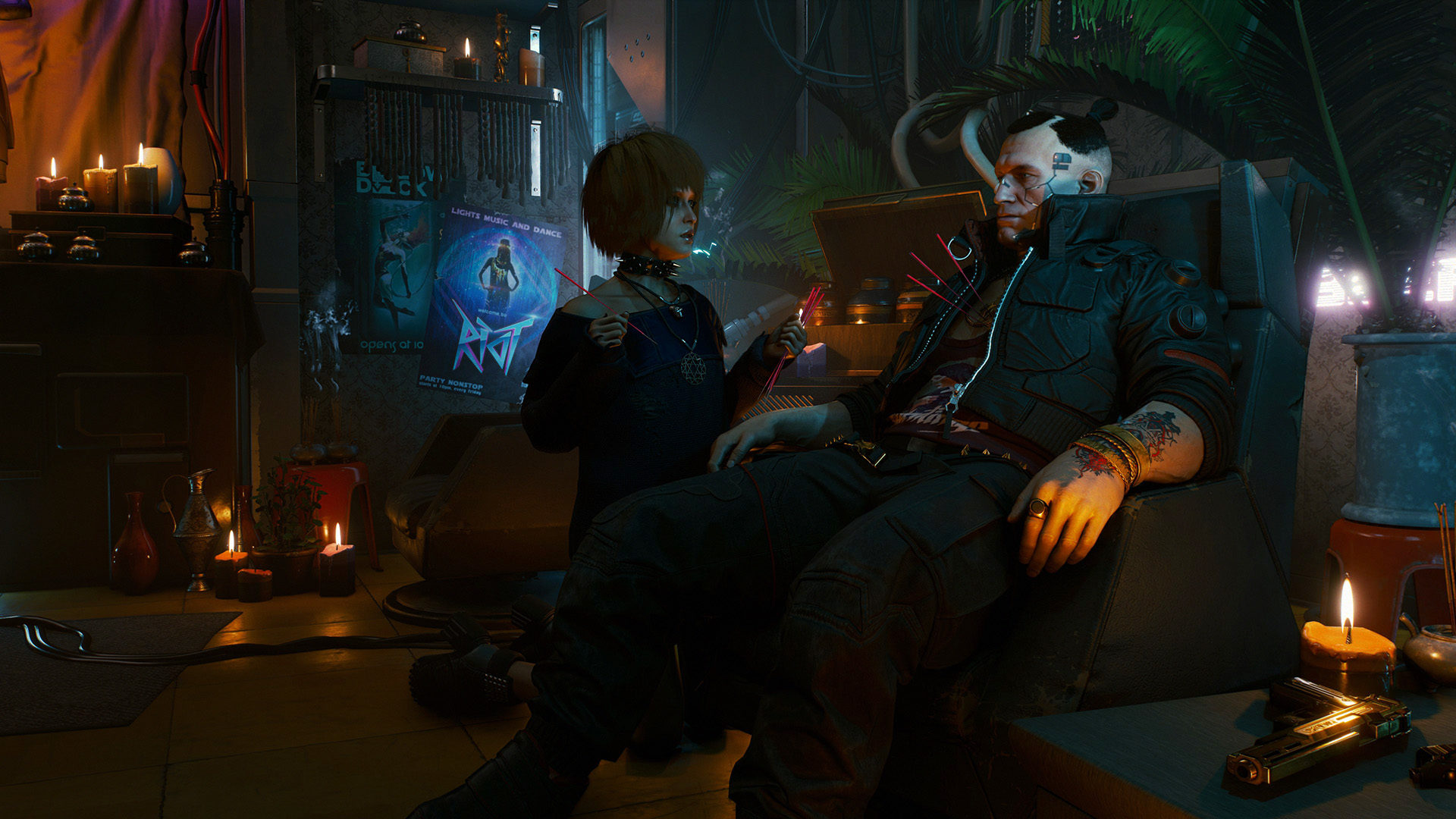As I played Cyberpunk 2077, I found my mind constantly drifting to two images. The first was Hong Kong’s now demolished Kowloon Walled City. The second was the infamous SimCity 3000 build Magnasanti, itself inspired by the documentary Koyaanisqatsi’s shots of the Pruitt-Igoe housing project. The connection isn’t hard to spot. In purely visual terms, they both resemble portions of Cyberpunk‘s Night City, a sprawling and dense, futuristic and decrepit metropolis.
But in retrospect, there’s a tension between the two images that’s both interesting and telling to consider in light of the game. Magnasanti—and even Pruitt-Igoe—reflects the height of central planning, the idea that you can draw a map to define the territory. By contrast, the authorities in Hong Kong did not construct Kowloon. They couldn’t even govern it. It was an urban microcosm built from the ground up, over time, at the scale of individuals. Yet somehow, on some level, they rhyme. As above, so below.
The strength of Night City—and by extension one of the few true strengths of Cyberpunk 2077 as a whole—is the way its form and worldbuilding push this idea to the forefront. Megabuildings thrust up into the sky, presenting outwardly as monoliths, but in their dizzying atria you can see the grungy, organic communities emerging within: laundry hanging from wires, businesses springing up where they have no right to be, so many code violations you start to wonder if building codes even exist anymore. To navigate Night City is to walk in the gap between what the powerful tell us something will be and what the powerless will make of it. What emerges when those two visions confront each other without being reconciled is often unpleasant but always fascinating. In that way, the game becomes a silent commentary on itself—and not an altogether flattering one.

The pitch CD Projekt Red gave the world for Cyberpunk 2077’s gameplay was almost criminally transparent. Connect the open-world action of Grand Theft Auto with a story-driven RPG in the vein of Fallout or Skyrim. (This may or may not be controversial, but I think the flavor here is more recognizably Bethesda than it is CDPR’s own Witcher series.) You could also throw in the immersive sim elements of Deus Ex and Dishonored and the hacking of Watch Dogs, if you want, but at some point there’s enough overlap that going more granular yields diminishing returns.
When you hang your hat on building a hybrid, however, the components need to be nearly as good as your inspirations, and they need to blend into something cohesive. Cyberpunk 2007 fares poorly on both fronts. CD Projekt Red built two inferior replicas, and failed to harmonize them in any meaningful way.
To start with the GTA equivalents, Cyberpunk’s stand-in for the “Wanted” system is essentially worthless: Police spawn out of nowhere, just behind your back, and there’s no tension in getting away since vehicles can’t give chase. The non-quest side content is complete filler—all minor variations on killing a small group of people and opening a box. Random NPCs in the environment look nice and varied, but the lack of proper pedestrian or traffic AI, let alone an interesting toolset for unleashing mayhem, mean you’ll probably play through the entire game without a single interesting emergent moment in the open world. Despite the wonderful architecture, this absence of interaction (not to mention the many, many bugs) undermines the sense of place, of being in Night City. The overall flow of gameplay is so driven by map icons that you never feel like you’re exploring or being rewarded for exploration.
Cyberpunk 2077 even manages to fumble something as simple as the minimap. In GTA, getting into a vehicle zooms out the minimap so you can see further ahead of you. In Cyberpunk, it stays so closely cropped that if you’re driving in a car any faster than around 40 miles per hour, it’s literally impossible to spot an upcoming turn on your GPS route fast enough to slow down in time to make the turn. Mediocre handling on the cars doesn’t help matters.

In some respects, Cyberpunk 2077’s RPG half is more fully realized. At the very least, there are many of the things you expect, and you can play through them the way you’d expect to. You get quests that let you choose different outcomes, and multiple routes to accomplish your objectives based on the strengths of your character build, split into attribute points and perk trees. You get branching dialogue, and romance options, and a seemingly endless supply of incrementally better loot.
And you get a main narrative framed as an epic quest, but despite a charmingly weird, surprisingly game performance from Keanu Reeves as Johnny Silverhand—a digital imprint of a long-dead anti-corporate rock musician/terrorist trapped inside your head via an experimental chip that is slowly killing you—I’m not sure Cyberpunk’s storytelling really works for me. Yes, it hammers home all the expected cyberpunk tropes. Trying to make a name for yourself in the criminal underworld. Rogue AI. Corporate intrigue. Heists gone wrong. Et cetera. Et cetera.
Homage can only take you so far, though, and Cyberpunk doesn’t know when to stop. Putting one Blade Runner nod in a game is cute. Repeatedly mining Blade Runner for references, up to and including during one of the endings, just makes it feel like you’re scared that if you don’t lean on things people already like you’ll fall on your face.

Even the potentially exciting ability to choose your own backstory, from one of three, turns out to be underbaked. Following a pretty linear intro, you’re railroaded into the same storyline via montage, with no lingering repercussions beyond some additional dialogue that seldom leads anywhere and, at least on the path I chose, one optional quest that lasted 10 seconds.
The main issue, though, is that the story’s stakes are so far out of whack as to be laughable. The throughline of the narrative, the lone driving objective, is to save your own life, and possibly Johnny’s. To accomplish this task, you’ll need to slaughter (or at least maim) hundreds, if not thousands of people, many of whom are no more self-serving than you are. To top it all off—and skip to the next paragraph if you don’t want to have the endings broadly spoiled—there’s actually no way to save yourself beyond six more months of terminal illness. Whoops! All that bloodshed was for nothing! I get it. Cyberpunk can often be nihilistic. Night City is supposed to be brutal and unflinching. But wasting your time on a fool’s errand and barely commenting on that fact does not a satisfying RPG story make.
Still, I’d argue that what elevates Fallout and The Elder Scrolls is not their main quests, but their memorable side stories. That’s even more true of CDPR’s own Witcher 3: Wild Hunt. The few thought-provoking sidequests Cyberpunk 2077 offers ultimately fizzle. Seemingly thorny moral quandaries reveal themselves as hollow—so many of your choices have no real impact in the end. The worst offender is a quest centered on a death-row inmate who’s agreed to be crucified while capturing his final moments as a braindance—a full-sensory recording that plays back directly into your brain. Having found God in prison, the murderer believes he can be a vessel for the Word of God, that letting others live out the crucifixion firsthand will help spread the gospel. But is he crazy? Is the corporation just exploiting him to make a quick buck? The entire time I thought I was making tough choices in some ethically gray matrix. Well, I looked it up online, and it turns out my only real choice was to let it unfold while watching or to walk away from the questline and—I must assume—let it unfold anyway. Oof.
Of course, systems are just as important to an RPG as story, if not more so. Cyberpunk 2077’s skill trees and attributes are neat—refreshingly different in a way that suits the setting. They’re also shoddily implemented. It’s not just that CD Projekt Red obviously thought through certain builds far more than others, making them more useful and fun. There’s also, in my estimation, a deeper failure to sufficiently playtest and balance those systems to make them rewarding for players who want to specialize.

I’ll admit that I took the easiest route by focusing on the Mantis Blades as my primary weapon. As has been well-documented by now, they’re so much more efficient in combat than any gun- or hacking-centric build. By the time I was midway through the story, I could slow time at the start of every encounter and cut down just about every enemy in two swipes, decimating most of a group before they could fight back. And if I did take damage, my perks meant I could regain a ton of health with every single kill. I honestly think, across the entire back half of the game, I used less than a dozen healing items.
The inattention to detail goes even further than that, though. Each skill in Cyberpunk has its own levelling system—a bit like Skyrim—allowing you to earn XP each time you use it. If you want to unlock the final perk for a skill, you’ll need to max it out to level 20. I used blade weapons—and solely blade weapons—in nearly every combat encounter. I finished every quest and cleared out the entire open-world map. I slap-chopped thousands of goons. My blade skill is presently at level 18, the last perk still locked away. (No other skill is even close to that high.) I’m honestly not sure how I could have put more focus into blades, beyond running around swiping at randomly spawning gang members for hours. Given that there’s no New Game+ option, I have to assume that tedious grind is the only way to top it off, aside from waiting for DLC to arrive.
I’m not going to speculate about how much content the developers may or may not have cut to make a 2020 launch, but it’s clear that the game wasn’t properly tuned to account for the amount of content we did get. For an RPG, I think that’s inexcusable.
I’m focusing on one small corner of the systems, to be sure. But that corner is indicative of the overall lack of care that holds Cyberpunk 2077 back. It’s easy to write off the game as merely buggy or unpolished, as if patches and content updates will eventually bring it in line with pre-launch excitement. I think that narrative is fundamentally wrong. The deeper problem is that what’s already here doesn’t hold up to scrutiny. To make everything hang together would be a matter of, functionally speaking, redesigning the entire game. In architectural terms, they’d have to strip it to the studs, if not the foundation.
You can milk 60-plus hours out of Cyberpunk 2077 and have a decent time, especially if you play on a next-gen console or PC. But the game will take almost as much in patience and understanding as it rewards in enjoyment. Even under the best conditions, the experience is undoubtedly compromised, and to pretend otherwise is to engage in wishful thinking. Any idea of its greatness, present or potential, remains a mirage, shimmering in the lingering heat of our collective anticipation. Get closer, and you’ll realize the image never touches the ground. Above and below—the halves cannot meet in the middle.
All images: CD Projekt.
|
★★☆☆☆
Cyberpunk 2077’s bugs and technical issues certainly hold it back, and with any luck those will be fixed in the coming months. But it’s more difficult to imagine CD Projekt Red doing enough to resolve the deeper problems: awkwardly balanced systems, storytelling misfires, and an inability to merge its open-world action and RPG gameplay into something smooth and cohesive. |
Developer CD Projekt Red Publisher CD Projekt ESRB M - Mature Release Date 12.10.2020 |
| Cyberpunk 2077 is available on Xbox One, PlayStation 4, Windows PC, and next-gen consoles via backward compatibility.. Primary version played was for PlayStation 5. Product was provided by CD Projekt for the benefit of this coverage. EGM reviews on a scale of one to five stars. | |
